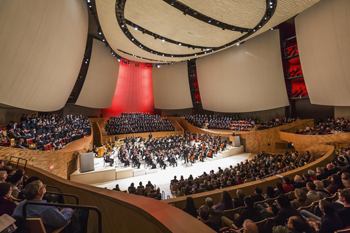Stanford Celebrates Opening of New Concert Hall
 STANFORD, Calif. — Stanford University held a grand opening for the 842-seat Bing Concert Hall January 11 with a three-day commemoration to sold out audiences and a diverse collection of musical performances.
STANFORD, Calif. — Stanford University held a grand opening for the 842-seat Bing Concert Hall January 11 with a three-day commemoration to sold out audiences and a diverse collection of musical performances.
Designed by Richard Olcott of New York-based Ennead Architects and constructed by Turner Construction Company, headquartered in New York City, the 112,365-square-foot $122 million vineyard style concert hall includes state-of-the-art acoustic design by internationally renowned acoustician Yasuhisa Toyota.
“Good acoustics in a concert hall serves to enhance the audience’s experience
by making it easier to understand the performance they are enjoying,” Toyota said. “When the sound is rich and clear, we can fully understand the musicians and composer’s intent for our enjoyment.”
Music and acoustics are inseparable, Toyota said, and if the both music and acoustics are not appealing audiences can easily become distracted.
The room shape itself and the materials have the greatest influence on the acoustical design of a concert hall,” Yasuhisa said.
Yasuhisa and Olcott worked closely in order to produce the most effective design to utilize acoustics.
“The Bing Concert Hall exemplifies the seamless exemplifies the seamless integration of architecture, acoustics and technology with the goal of transforming the practice study and experience of the performing arts at Stanford,” Olcott said in a statement.
Double curved ceiling reflectors 48 feet above the stage housing the state-of-the-art technical lighting, rigging and sounds support equipment.
The Stanford Arts Initiative, the driving force in bringing a new concert hall to the Stanford campus, wished for a kind of versatility that would pay homage to the wide variety of musical artists on campus.
“In addition to achieving acoustical excellence, the client’s objectives for the design of Bing Concert Hall recognized the changing nature of classical music performance,” said theatre planner and designing firm Fischer Dasch and Associates in a statement. “Contemporary classical soloists, orchestras, and chamber groups are increasingly experimenting with visual media, lighting, and movement, and the hall has been carefully designed to facilitate these more theatrical types of musical presentations.”
Stanford Lively Arts Executive and Artistic Director Jenny Bilfield said Bing Hall has brought connectivity and flexibility to artists and the audience. While the acoustics and design welcome both acoustic and amplified sounds, the vineyard style seating allows a more accessible musical experience. For concert attendees
“My favorite part is that it’s designed with a social quality and human quality for the audience in attendance,” Bilfield said. “We wanted the audience to be able to hear the grittiness or striking tone of the bow hitting the violin and the artist a range of expressivity that will be heard.”
From any seat in the concert hall concert goers will be able to experience the same high quality sound while being in sight line of the performance and other audience members.
“The vineyard style configuration, whose terraced seating sections ring the stage, creates an intimate concert experience, a warm and rich environment for audience and performers,” Olcott said in a statement. “Each seating section has a unique and intimate feel, particularly the center-section seating, which begins at the same level of the stage.”
Despite the price of your ticket, Bilfield said, the structure of seating allows each audience member to feel a part of the artistic community.
“You see people, you see students, you see people of all ages,” Bilfield said. “There’s an active awareness of your placement in the experience.”
